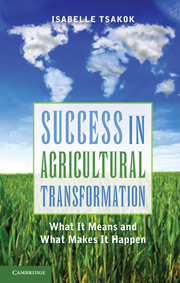Book contents
- Frontmatter
- Contents
- Figures and Table
- Preface
- Acknowledgments
- Summary
- Introduction
- Part One The many faces of agricultural transformation in an industrializing world and what it means
- I The Industrialized World
- II The Developing World
- Part Two Success in Agricultural Transformation: What Makes It Happen?
- Appendices
- Select Bibliography
- Index
I - The Industrialized World
Success in Agricultural Transformation in England, Japan, and the United States
from Part One - The many faces of agricultural transformation in an industrializing world and what it means
Published online by Cambridge University Press: 05 June 2012
- Frontmatter
- Contents
- Figures and Table
- Preface
- Acknowledgments
- Summary
- Introduction
- Part One The many faces of agricultural transformation in an industrializing world and what it means
- I The Industrialized World
- II The Developing World
- Part Two Success in Agricultural Transformation: What Makes It Happen?
- Appendices
- Select Bibliography
- Index
Summary
England’s Agriculture in the 18th and 19th Centuries
Summary. The agricultural revolution in the 18th and 19th centuries in England is the first known case of successful agricultural transformation. England’s experience is both good and bad news for those who argue that agricultural development is necessary at the early stages of industrialization.
The good news is that agriculture’s contribution was substantial and timely. Economic historians argue that, without such contribution, England’s industrial revolution might well have been aborted. Counterfactuals are hard to prove. The counterclaim, however — that England’s agricultural development could have been bypassed — has no supporting evidence.
The bad news is that agricultural development alone did not immediately generate substantial benefits for poor rural households. The poor had to wait for decades after the start of the agricultural and industrial revolutions and after massive emigration to the New World tightened labor markets, thus enabling their wages to rise.
- Type
- Chapter
- Information
- Success in Agricultural TransformationWhat It Means and What Makes It Happen, pp. 15 - 59Publisher: Cambridge University PressPrint publication year: 2011



